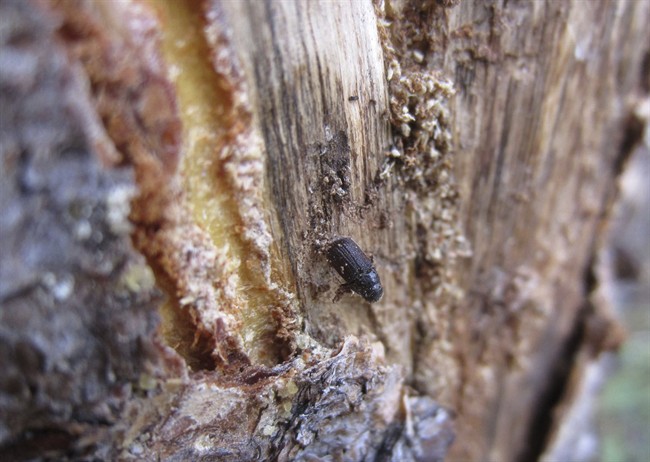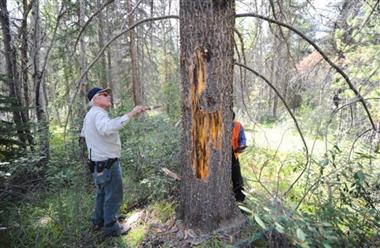A massive and uncontrollable buildup of mountain pine beetles in Jasper National Park is starting to explode into commercially valuable forests along its boundaries.

Foresters along the park’s edge have seen a tenfold increase in beetle infestation in just months, and some scientists wonder if Parks Canada could have done more to control the invasion a few years ago.
“They decided to consider the pine beetle a ‘native disturbance agent,'” said Allan Carroll, who has studied the beetles since the late 1990s and directs the University of British Columbia’s Forest Science program.
“In other words, Jasper was not intending to do much about it.”
READ MORE: Increased wildfire risk in Jasper due to pine beetles, says MP
In an emailed statement, Parks Canada said it has had a beetle management plan for the park since 2015 that includes prescribed burns and tree removal.
Too little, too late, said Carroll.
“Just that hesitation intrinsic to producing a management plan precluded any effective outcomes.”
Janice Cooke, associate professor at the University of Alberta and director of the NSERC TRIA Mountain Pine Beetle Strategic Network, expects within five years the forest in the park will look drastically different.
“Many of the pines that you can see from the Highway 16 corridor through the park will have been killed by the beetle,” she said.
- Enter at your own risk: New home security camera aims paintballs at intruders
- Boston Dynamics unveils ‘creepy’ new fully electric humanoid robot
- Ontario First Nation calls for chemical plant to be shut down amid ‘dangerously high’ benzene levels
- Nova Scotia scraps spring bear hunt idea, public ‘very divided’ on issue
Cooke said a small cluster of infected trees at the west gate only a few years ago has now turned into more 10,000 infected trees today, with the number set to spike even higher as the outbreak of the destructive Mountain Pine Beetle further spreads.
Spread into Hinton
The outbreak has spread from the west entrance of Jasper to the point where attacked trees are now being detected beyond the eastern border of the park.
West Fraser Timber manages about 13,000 square kilometres along the park’s eastern edge and runs a large mill in the town of Hinton just outside the boundary. The company removed about 40,000 bug-infested trees last year.
That number has grown.
“The number that we have been told for this area is around half a million trees,” said Richard Briand, West Fraser’s woodland manager.
Why are the beetles so destructive?
Adult beetles fly during the summer, finding suitable pine trees and attacking them by boring through the bark. If enough beetles attack a tree, they can overcome the tree’s defenses and create galleries under the bark. The beetles carry fungal partners with them, which grow into the wood and block water transport up the tree.
“The pine trees basically are water starved to death,” said Cooke.
“The red needles that we see are the consequence of water not making it from the roots to the branches because of the beetles and their fungi.”
READ MORE: ‘Beautiful smell’ is a tree’s worst enemy against mountain pine beetles

For years, the park and forests to the east and south of it missed the worst of the beetle infestations that ravaged British Columbia and southern and northern Alberta. Cold kept them out.
READ MORE: How a beetle outbreak may have caused two sawmill explosions in B.C.
In northern Alberta, the bugs were able to avoid severe alpine temperatures by flying east over some of the lowest elevations in the Rockies. In the south, the mountains are high but the invaders benefited from warmer temperatures.
Several unusually warm winters finally allowed the beetles to breach Jasper’s defences. They thrived in the park’s large, mature pine forests.
In 2014, beetle activity went from a few spots around Jasper’s townsite to rampant, said Carroll. And it’s worsened ever since.
Was the outbreak is ‘beyond controllable?’
“The outbreak is probably beyond a controllable situation,” said Mike Underschulz of Alberta Agriculture. “The area around Hinton is a very great concern.”
Underschulz said the eastward spread of red trees killed by pine beetles was inevitable.
“It was probably five years ago when I saw the sea of red in B.C. coming up to the park. I knew it was only a matter of time,” he said.
“There may have been some points in time that Jasper could have implemented a more aggressive control program. Looking back, it wouldn’t have amounted to anything.”
We did our best, said Parks Canada. More than 3,000 affected trees were removed last winter and a 70-hectare break was cut along the eastern boundary, in part to slow the beetle’s spread. Those programs will continue.

Managers have to be extra careful in a national park, said the agency’s statement.
“Prescribed fires are only conducted under exacting conditions and will only go forward when the safety of the public, our crews, park infrastructure and neighbouring lands can be assured.”
READ MORE: Mathematics used to study pine beetle control methods
Carroll points out that Banff National Park’s beetle control has been much more successful.
“Banff was very aggressive in treating beetles that were on the margins of the park. They did that for six or eight years and were capable of slowing the spread so that the beetles collapsed naturally.”
What’s next for Alberta’s commercial forests?
Either way, West Fraser and the town of Hinton will have to live with hugely infested forests.
Briand said West Fraser has dealt with beetles before.
Harvest plans will be adjusted so the most susceptible stands are harvested first. Reforestation will have to be increased. Salvage logging will go on for years.
“It will add costs to our operations,” he said. “If it gets away from us, it will have negative impacts on the availability of timber in about 20 years.”
Hinton Mayor Marcel Michaels said 645 people work in West Fraser’s mill in his town, the biggest single employer and Hinton’s largest taxpayer. And there are concerns about wildfires if the community is surrounded by thousands of dead trees.
Town council has created an advisory committee to bring together municipal officials, industry representatives and scientists to figure out how to deal with the problem.
“We cannot accept doing nothing,” said Michaels. “Right now, we’re just throwing darts at the dartboard.”
“This Mountain Pine Beetle outbreak has every potential to radically change the landscape of the forests in the mountain parks in the same way that we saw in British Columbia a decade ago,” Cooke said.
READ MORE: ‘It’s just a sad day’: Vernon based Tolko shutters Merritt mill
— With files from Karen Bartko, Global News



Comments